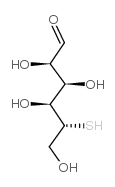5-THIO-D-GLUCOSE

5-THIO-D-GLUCOSE structure
|
Common Name | 5-THIO-D-GLUCOSE | ||
|---|---|---|---|---|
| CAS Number | 20408-97-3 | Molecular Weight | 196.22100 | |
| Density | 1.503 g/cm3 | Boiling Point | 463.3ºC at 760 mmHg | |
| Molecular Formula | C6H12O5S | Melting Point | 135-138ºC(lit.) | |
| MSDS | USA | Flash Point | 234ºC | |
|
Thrombin mediates vagal apoptosis and dysfunction in inflammatory bowel disease.
J. Gastrointest. Surg. 18(8) , 1495-506, (2014) In inflammatory bowel disease, autonomic dysfunction contributes to symptoms, morbidity, and health care resource utilization. Efferent vagal neurons, which provide the primary parasympathetic input to the gastrointestinal tract, are housed in the dorsal moto... |
|
|
GLUT2 in pancreatic islets: crucial target molecule in diabetes induced with multiple low doses of streptozotocin in mice.
Diabetes 47 , 50-56, (1998) In mice, diabetes can be induced by multiple low doses of streptozotocin (MLD-STZ), i.e., 40 mg/kg body wt on each of 5 consecutive days. In this model, diabetes develops only when STZ induces both beta-cell toxicity and T-cell-dependent immune reactions. The... |
|
|
The use of fluoro- and deoxy-substrate analogs to examine binding specificity and catalysis in the enzymes of the sorbitol pathway.
Carbohydr. Res. 313(3-4) , 247-53, (1998) The carbohydrate specificity of the two enzymes that catalyze the metabolic interconversions in the sorbitol pathway, aldose reductase and sorbitol dehydrogenase, has been examined through the use of fluoro- and deoxy-substrate analogs. Hydrogen bonding has b... |
|
|
Intraperitoneal CCK and fourth-intraventricular Apo AIV require both peripheral and NTS CCK1R to reduce food intake in male rats.
Endocrinology 155(5) , 1700-7, (2014) Apolipoprotein AIV (Apo AIV) and cholecystokinin (CCK) are secreted in response to fat consumption, and both cause satiation via CCK 1 receptor (CCK-1R)-containing vagal afferent nerves to the nucleus of the solitary tract (NTS), where Apo AIV is also synthes... |
|
|
Localized glucoprivation of hindbrain sites elicits corticosterone and glucagon secretion.
Am. J. Physiol. Regul. Integr. Comp. Physiol. 292(5) , R1792-8, (2007) Glucose is required for brain energy metabolism. Decerebration, aqueduct occlusion, and cannula mapping studies have established that glucose-sensing cells capable of eliciting feeding and adrenal medullary responses to glucoprivation are localized in the hin... |
|
|
Hypothalamus-brain stem circuitry responsible for vagal efferent signaling to the pancreas evoked by hypoglycemia in rat.
J. Neurophysiol. 91(4) , 1734-47, (2004) Circulating glucose levels significantly affect vagal neural activity, which is important in the regulation of pancreatic functions. Little is known about the mechanisms involved. This study investigates the neural pathways responsible for hypoglycemia-induce... |
|
|
Longer-term fourth ventricular 5-thioglucose infusion increases body fat in the rat.
Proc. Soc. Exp. Biol. Med. 217(2) , 168-72, (1998) 5-Thioglucose (5-TG) has been shown to increase food intake after acute administration. To determine the longer-term effects of 5-TG on feeding and body composition, thirty-four female Sprague-Dawley rats were cannulated into the fourth ventricle and infused ... |
|
|
Brain antioxidant capacity in rat models of betacytotoxic-induced experimental sporadic Alzheimer's disease and diabetes mellitus.
J. Neural Transm. Suppl. (72) , 235-40, (2007) It is believed that oxidative stress plays a central role in the pathogenesis of metabolic diseases like diabetes mellitus (DM) and its complications (like peripheral neuropathy) as well as in neurodegenerative disorders like sporadic Alzheimer's disease (sAD... |
|
|
The effects of NPY and 5-TG on responding to cues for fats and carbohydrates.
Physiol. Behav. 65(4-5) , 685-90, (1999) Previous research has shown that glucoprivic and lipoprivic metabolic challenges selectively augment the performance of appetitive responses conditioned to carbohydrate- and fat-associated cues, respectively. The present experiment investigated whether intrac... |
|
|
Role of the binuclear manganese(II) site in xylose isomerase.
Met. Ions Biol. Syst. 37 , 365-405, (2000)
|